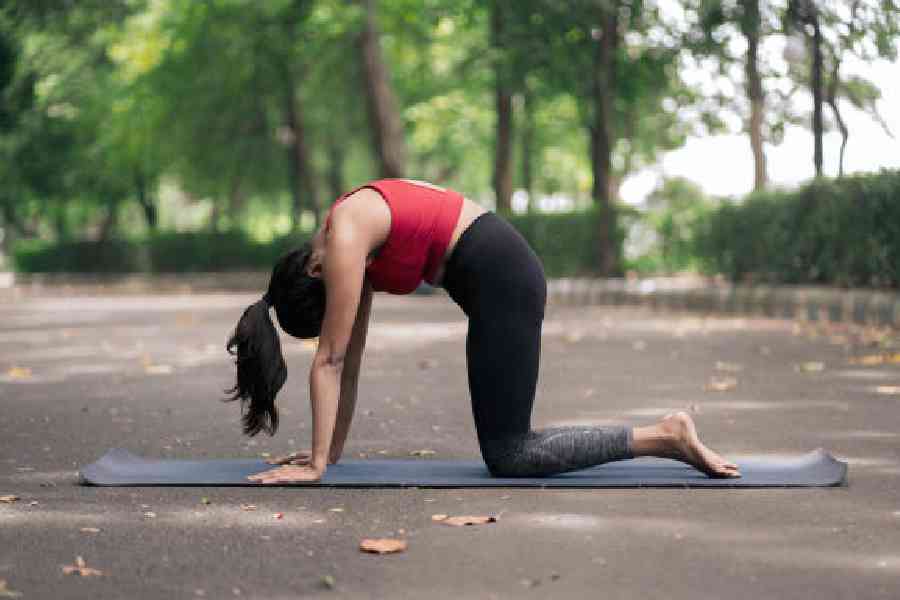For thousands of years, humans have hunched over to light fires, care for children and harvest plants. But the modern version of this position — curving forward from focus or fatigue, then lifting our chins to stare at our screens — can lead to pain for many people.
This neck and upper back discomfort is often called “tech neck” or “text neck”. Experts say it’s not necessarily the position itself that is a problem but the amount of time we spend in it.
Tech neck hasn’t been rigorously studied but experts say there are changes you can make that will likely offer some relief. First, check that your work station allows you to sit with good posture. Stretches that release tension in the muscles along the neck and the tops of the shoulders can help, too. It’s also important to strengthen the muscles in your mid-back and along your spine, and improve your mobility in these areas.
The following routine includes exercises that check each of these boxes — and many of them can be done at your desk. Most can be performed daily, as needed, to relieve tension and discomfort. Shoulder rows can be performed up to three or four times per week as part of a regular strength training routine.
Chin tuck
Repetitions: Two or three sets of five to eight repetitions.
Purpose: Releases tension near the base of your skull and improves strength to correct forward head posture.
Sit tall, and gaze forward with your shoulders relaxed by your sides. Tilt your head down and then press your chin backward, like you’re making a double chin. Hold for two to three seconds, then release. This movement can be quite small, but you should feel a stretch where your hairline meets the top of your neck.
Upper trap stretch
Repetitions: Two or three reps per side.
Purpose: Releases tension in the muscles along your upper back and neck.
Sit or stand tall with your shoulders relaxed, gazing forward. Tilt your right ear toward your right armpit. Press your left shoulder slightly down, away from your ear. Hold for 30 to 60 seconds, then release.
Use a range of motion that feels comfortable. You may only be able to tilt your head slightly. If you have a larger range of motion, for a deeper stretch you can anchor your opposite hand down by sitting on it or holding the side of your chair.
Levator stretch
Repetitions: Two or three reps per side.
Purpose: Releases tension in the muscles along the sides of your neck.
Sit or stand tall, with your shoulders relaxed naturally, and gaze forward. Tilt your right ear toward your right shoulder, then rotate your neck slightly so your nose is pointing toward your armpit. Press your left shoulder slightly down, away from your ear. Hold for 30 to 60 seconds, then release.
Like the previous stretch, you can anchor your opposite hand if you feel comfortable.
These two stretches may look very similar, but you should feel them in different parts of your neck and shoulder. For each one, pay attention to what feels good: it may be that both sides need attention, or you may discover that you hold a lot of tension on one side and not so much on the other. If that’s the case, you can focus on the tense side and skip the other side.
Cervical rotation
Repetitions: Five reps per side.
Purpose: Improves mobility in the muscles that help you turn your head.
Sit or stand tall, with your shoulders relaxed, and gaze forward. Place your right pointer and middle fingers on the right side of your temple — or on another comfortable spot on the side of your face, like your jaw or cheekbone — and try to turn your head to the right as your hand resists. Hold for five seconds, then relax. You can try to turn your head all the way to one side and then apply pressure with your head rotated.
Supine snow angels
Repetitions: Two or three sets of six to eight repetitions.
Purpose: Stretches the muscles in your chest and helps improve thoracic spine mobility.
Lie on your back, with your arms out to your sides and your elbows and the backs of your wrists resting on the floor. Keep contact with the floor as you reach your arms overhead, then return to the start position with control. You should feel a nice stretch in your chest muscles.
Cat-cow
Repetitions: Move smoothly between the two positions for 30 to 60 seconds.
Purpose: Improves mobility and body awareness along the spine.
From all fours, inhale as you lift your head and tail bone, allowing your belly to drop and your back to arch. Feel your chest open and your shoulder blades glide back and down. Exhale as you round your back, allowing your head and tail bone to point down toward the floor, lifting your belly and the middle of your back.
If you aren’t comfortable on your hands and knees, you can perform cat-cow seated in a chair (with your hands on the back of your head) or standing and hinging forward with your hands on your thighs.
Bent-over rows
Repetitions: Two to four sets of six to 10 repetitions.
Purpose: Builds strength in the back muscles that support your shoulder blades and counteracts neck and upper back pain.
Stand with a dumbbell in each hand. (Choose a weight that feels moderate to heavy to you) Hinge forward until your torso is level with or close to parallel with the floor and your arms are hanging straight down. Bend your elbows to pull the weights closer to you, stopping when your elbows are even with your trunk. Then lower with control to the starting position.
NYTNS










